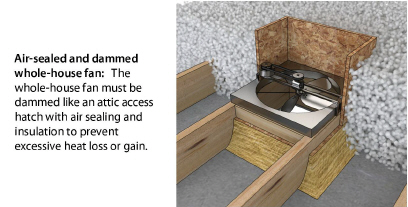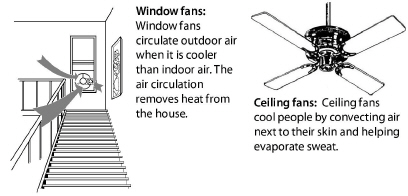
|
SWS Detail: 2.0401.2 Vented Crawl Space—Venting, 2.0107.2 Basements and Crawl Spaces—Pre-Work Qualifications, 2.0107.3 Basements and Crawl Spaces—Debris Removal, 2.0404.3 Closed Crawl Spaces—Crawl Space Conditioning, 2.0701.1 Crawl Spaces—Providing New Access |
Before taking steps to improve crawl-space ventilation, comply with these requirements.
✓ The crawl space should have an access hatch or door that is adequate for a worker or resident to enter or exit.
✓ Correct grading, drainage, and gutter-and-downspout problems related to crawl-space moisture problems.
✓ Install a ground moisture barrier as specified in “Crawl Space Moisture and Safety Issues” on page 41.
9.10.1 Naturally Ventilated Crawl Spaces
|
SWS Detail: 2.0401.1 Air Sealing Moisture Precautions, 2.0403.1 Vented Crawl Spaces—Ground Moisture Barrier |
Naturally ventilated crawl spaces are often not a good application in Minnesota.
When insulating the floor, the crawl space is usually ventilated naturally through passive vent openings in the foundation wall. A ground moisture barrier protects the floor insulation and other building materials from moisture. The vent openings can remove small amounts of moisture from the crawl space. Two specifications apply to ventilated crawl spaces.
1. A crawl-space with a ground-moisture barrier may have vent openings equal to 1 square foot of vent area to 300 square feet of crawl-space floor area. A minimum of two vents should be installed on opposite corners of the crawl space.
2. In a dry crawl space with a ground-moisture barrier, ventilation openings may be minimized to one square foot of net free ventilation area for every 1500 square feet of crawl-space floor area, according to the 2012 IRC.
Decommissioning whole house fans is usually the best option. If this is not possible, ensure the fan has an airtight cover. Some fans come with a tight-sealing winter cover. If the fan doesn’t have such a cover, or if the attic access doesn’t allow you to cover the fan easily, then you can fabricate a cover for the grille on the ceiling. A seasonal cover, held in place with rotating clips or spring clips and sealed with foam tape, works well.

Window fans are best used in windows facing the prevailing wind or away from it to provide cross ventilation. Window fans can augment any breeze or create a breeze when the air is still. If the wind direction changes in your area, use reversible type window fans so you can either pull air into the home or push air out, depending on which way the wind is blowing. Experiment with positioning the fans in different windows to see which arrangement works best.

Air circulating fans are very effective cooling energy savers. Air circulating fans may allow a 4 degree rise in the thermostat setting with no decrease in comfort.
Use circulating fans with air conditioners, evaporative coolers, whole-house fans, or by themselves. Circulating fans save cooling energy by increasing air movement over the skin to help occupants feel cooler.
Ceiling fans and various types of portable fans provide more comfort at less cost than any other electrically powered cooling strategy. Options include: small personal fans that sit on tabletops, or heavier units that sit on the floor or on metal stands with wheels.
Ceiling fans produce high air speeds with less noise than oscillating fans or box fans. High quality ceiling fans are generally more effective and quieter than cheaper ones.